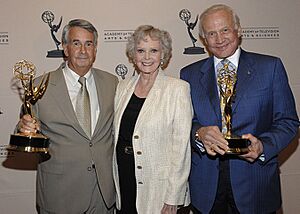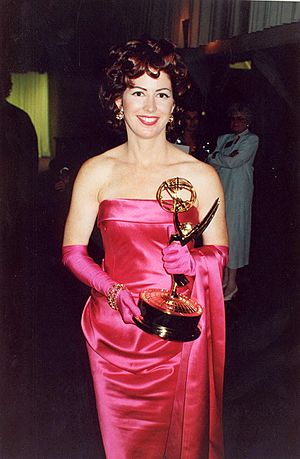Emmy Awards facts for kids
Quick facts for kids Emmy Awards |
|
|---|---|

Emmy Awards logo.
|
|
| Presented by | ATAS/NATAS/IATAS |
| Country | United States |
| First awarded | January 25, 1949 |
The Emmy Awards, or Emmys, are special prizes given for amazing work in the television industry. Think of them like the Oscars for movies or the Grammys for music, but for TV shows!
Many Emmy Award shows happen throughout the year. Each show has its own rules and categories. The most famous ones are the Primetime Emmy Awards and the Daytime Emmy Awards. These celebrate the best TV shows that air in the evening and during the day in America.
Other important Emmy awards include:
- The Children's & Family Emmy Awards for shows made for kids and families.
- The Sports Emmy Awards for sports programs.
- The News & Documentary Emmy Awards for news and documentary shows.
- The Technology & Engineering Emmy Awards and Primetime Engineering Emmy Awards for cool inventions and improvements in TV technology.
There are also Regional Emmy Awards across the country. These awards honor great local TV shows. Plus, the International Emmy Awards celebrate awesome TV shows made outside the United States.
The Emmy statue looks like a winged woman holding an atom. It was named after "immy," which was a nickname for a special camera part used in early TV cameras. The Emmy is one of the four biggest entertainment awards in America. The others are the Grammy for music, the Oscar for movies, and the Tony for Broadway plays.
Three different groups give out the Emmys:
- The Academy of Television Arts & Sciences (ATAS)
- The National Academy of Television Arts & Sciences (NATAS)
- The International Academy of Television Arts and Sciences (IATAS)
Each group is in charge of different Emmy Award shows. The ATAS gave out the first Emmys in 1949. Back then, they only honored shows made in the Los Angeles area. In the 1950s, the awards became national. Over time, these groups added more awards for different parts of the TV world.
History of the Emmy Awards

The ATAS group in Los Angeles started the Emmy Award. They wanted to make TV look good and get people excited about it. The very first Emmy ceremony happened on January 25, 1949. It was held at the Hollywood Athletic Club. These first awards were only for shows made and shown in the Los Angeles area.
A person named Shirley Dinsdale won the first Emmy Award ever. She was named the Most Outstanding Television Personality. The name "Emmy" came from "Immy." This was a slang word for a part inside old TV cameras called an image orthicon tube.
In the 1950s, the ATAS made the Emmys a national event. This meant they honored shows shown all over the country. In 1955, the NATAS group was created in New York City. It was like a sister group to the ATAS. The NATAS helped serve TV people on the East Coast.
The ATAS kept its own awards for shows in Los Angeles. But the NATAS started local chapters across the U.S. Each chapter created its own Emmy awards for local TV shows.
At first, there was only one Emmy event each year for national shows. But in 1974, the first Daytime Emmy show was held. It was just for daytime TV programs. Soon, other special Emmy events started too. The International Emmy Awards also began in the early 1970s. These awards honor TV shows made outside the U.S.
In 1977, the ATAS and NATAS groups decided to work separately. They agreed to share the Emmy statue and its name. Each group would be in charge of different award shows. For example, the NATAS gives out the Technology & Engineering Emmy Awards. The ATAS gives out the separate Primetime Engineering Emmy Awards.
When cable TV became popular in the 1980s, cable shows could also win Primetime Emmys starting in 1988. They could win Daytime Emmys starting in 1989. Later, shows made for online streaming services also became eligible for Emmys.
In December 2021, the ATAS and NATAS changed how the national Emmy Awards work. This was because streaming TV made it hard to tell if a show was "daytime" or "primetime." Now, the awards focus on the type of show, not just when it airs. For example, most scripted dramas and comedies moved to the Primetime Emmys. All children's shows moved to the new Children's & Family Emmy Awards. Morning shows moved to the News & Documentary Emmy Awards.
The Emmy Statuette
The Emmy statue shows a winged woman holding an atom. A TV engineer named Louis McManus designed it. He used his wife as the model for the statue. The ATAS group looked at 47 different designs before picking McManus's in 1948.
The statue shows the TV Academy's goal. It wants to support and improve TV art and science. The wings stand for the art side. The atom stands for the science side.
When they were choosing a name, someone suggested "Ike." This was a nickname for an old TV camera part. But "Ike" was also the nickname for future U.S. President Dwight D. Eisenhower. So, they wanted something different. Finally, another TV engineer suggested "Immy." This was a common name for the image orthicon tube in early cameras. After "Immy" was chosen, they changed it to "Emmy" to match the female statue.
The Emmy statues are different sizes and weights for different events. A Primetime Emmy statue weighs about 6.75 pounds (3 kg). It is made of copper, nickel, silver, and gold. It stands about 15.5 inches (39 cm) tall. Regional Emmy statues are a bit smaller. Each statue takes about five and a half hours to make. Workers wear white gloves to keep them clean.
The ATAS and NATAS own the Emmy statue and name. They have strict rules about using them. For example, the Emmy statue must always face left in pictures. If you win an Emmy, you need permission to use the statue's image for promotions.
Types of Emmy Awards
| Administering academy | Events |
|---|---|
| ATAS | Primetime, Creative Arts, Primetime Engineering, Los Angeles Area, College TV |
| NATAS | Daytime, Daytime Creative Arts, Children's & Family, Sports, News & Documentary, Technology & Engineering, Regional (except for Los Angeles), National Student Production |
| IATAS | International |
Many different Emmy competitions happen every year. They honor everything from national TV shows to local programs. Each event has its own categories, rules for nominations, and voting methods. Sometimes, different Emmy events have categories with the same name. For example, there's a Primetime Emmy for Outstanding Drama Series and a Daytime Emmy Award for Outstanding Drama Series.
A TV show usually can't enter more than one Emmy event. For example, a show that airs at different times in different places might be eligible for both Daytime and Primetime Emmys. But it can only choose one. Generally, a show is "national" if it reaches more than half of U.S. homes. If it reaches less, it might enter the Regional Emmys instead.
No matter which Emmy competition you win, you are called an "Emmy Winner."
Primetime Emmys

The Primetime Emmys celebrate the best American TV shows that air in the evening. The award show usually happens in mid-September. It is shown on major TV networks like ABC, CBS, NBC, and Fox. These networks take turns broadcasting the ceremony.
Some awards for people working behind the scenes, like art directors or costume designers, are given out at a separate show. This is called the Creative Arts Emmys. It happens a few days before the main Primetime Emmy show.
Members of the ATAS group vote for the Primetime Emmys. For most awards, members vote only in their own area of expertise. For example, directors vote for directing awards. But all members can vote for the best program categories. The final votes to pick the winners happen in August.
Daytime Emmys

The Daytime Emmy Awards celebrate excellent American daytime television shows. These awards are usually held in May or June. The first Emmy awards for daytime shows were given out in 1972. But the first separate show just for daytime programs was in 1974.
Like the Primetime Emmys, there's a separate Creative Arts Emmy show for daytime TV. This honors the people who work behind the scenes on daytime programs.
Members of the NATAS group vote for the Daytime Emmys. They use judging panels made up of people with experience in TV. Voting is done using different scoring systems, depending on the award category. For acting awards, there's an extra round to pick the top actors before the main nominations.
Sports Emmys
The Sports Emmy Awards are given by the NATAS for great work in sports programming. This award show happens every spring, usually in late April or early May. It is held on a Monday night in New York City.
Voting is done by judging panels. The NATAS asks people with lots of experience in national sports TV to be judges. Most categories have one voting round. The top five shows or people in each category are nominated. Then, the winner is announced at the awards ceremony.
News and Documentary Emmys
The News & Documentary Emmy Awards are given by the NATAS. They honor excellent national news and documentary programs. This award show takes place every fall.
Voting is done by judging panels. The NATAS asks people with lots of experience in news or documentary making to be judges. Most categories have two voting rounds with different judging panels for each. The top entries are nominated, and the winners are announced at the ceremony.
Children's and Family Emmys
On November 17, 2021, the NATAS announced a new award show. It's called the Children's & Family Emmys. These awards started in 2022. They celebrate the best in children's and family TV. Before this, most awards for kids' shows were part of the Daytime Emmys or Primetime Emmys. The NATAS created this new show because there are so many great children's and family programs now.
Engineering Emmys

The Primetime Engineering Emmy Awards (from ATAS) and the Technology & Engineering Emmy Awards (from NATAS) are two separate awards. They honor people, companies, or groups who make important new inventions or improvements in TV technology. The NATAS Engineering Emmys are usually in January. The ATAS Engineering Emmys are usually in October.
Each group has its own team of expert engineers. These engineers decide who wins their awards. One special ATAS award is the Philo T. Farnsworth Award. It honors companies that have greatly changed TV engineering over a long time.
Regional Emmys
There are 20 regional Emmy chapters across the United States. These chapters give out awards for great TV in local areas. This includes state-wide shows and local news programs. Nineteen of these chapters are connected to the NATAS. The Los Angeles chapter is part of the ATAS.
A show is usually considered "regional" if it doesn't reach more than half of U.S. homes. If it reaches more, it must enter one of the national Emmy competitions.
Like the national awards, each region has its own way of nominating and voting. Committees review entries to make sure they meet high standards. Then, different committees vote to pick the nominees. Finally, accounting firms count the votes to find the winners.
Donn Johnson, a president of a regional chapter, said in 2018 that "The Emmy Award is considered the most prestigious award a television professional can receive."
At first, Regional Emmy Awards mostly honored people in local news. But now, they include all local and state-produced shows that reach less than 50% of the country's viewers.
International Emmys
The International Emmy Awards celebrate excellent TV shows made outside the United States. The IATAS group has given these awards every year since 1973. The award ceremony usually happens in November in New York City.
Any non-U.S. TV company or person can submit a program. This includes networks, local stations, producers, directors, or writers. If a show is made by both U.S. and foreign companies, it might be eligible if it first aired outside the U.S. A show that enters the international competition cannot also enter any of the U.S. national ones.
Student Emmys
The College Television Awards are given by the ATAS. They honor great TV work made by college students. College students can submit their projects and win awards in categories like Comedy, Documentary, Drama, and News. Experts from the ATAS judge the entries. Winners are then chosen by special panels. Any work submitted must have a form signed by a teacher. This proves it was made for a school group, project, or class.
Similarly, the National Student Production Awards are given by the NATAS. They honor great TV work made by high school students. High school students can submit their projects and win awards in news, craft, and programming categories.
Special Recognition Awards
The Governors Award is the highest award from the ATAS. It honors a person, company, or group whose work has a big, immediate impact on society.
The Trustees Award is the highest award from the NATAS. It honors a person for their unusual or long-lasting achievements.
Humanitarian and Public Service Awards
The Bob Hope Humanitarian Award is given by the ATAS. It honors someone in the TV industry whose kind work has a lasting positive effect on society.
The Public Service Award is for public service announcements and programs. These are shows that help "advance the common good" for everyone.
See also
 In Spanish: Premios Emmy para niños
In Spanish: Premios Emmy para niños
- List of Daytime Emmy Award winners
- List of Primetime Emmy Award winners
- List of International Emmy Award winners
Other similar awards
- List of American television awards
- British Academy Television Awards (UK)
- National Television Awards (UK)
- Screen Actors Guild Award
- Streamy Awards
- Directors Guild of America Award
- Producers Guild of America Award
- Writers Guild of America Award
- TCA Awards
- Canadian Screen Awards – film and television industry awards in Canada
- Logie Awards – television broadcasting industry awards in Australia
- CableACE Award – a past award for Cable TV shows
- ITA Awards ( India)




